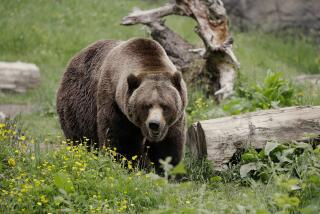Court restores federal protections for Yellowstone grizzly bears
- Share via
Conservationists touted a major victory Tuesday in their battle to protect Yellowstone grizzly bears when a federal appeals court ruled that wildlife managers erred when they removed Endangered Species Act protection from “one of the American West’s most iconic wild animals.”
The ruling by the U.S. 9th Circuit Court of Appeals struck down the U.S. Fish and Wildlife Service’s 2007 decision to remove the bears from the endangered species list. The court cited climate change as having accelerated a beetle infestation that destroys the bears’ vital white-bark pine food source, making the grizzly only the second wildlife species, after the polar bear, to earn protection in recognition of harm caused by global warming.
The three-judge panel took note of conservationists’ warnings that the loss of trees in the upper elevations in and around Yellowstone National Park would probably drive the grizzlies to forage in more populous areas, increasing confrontations between the omnivorous bears and the people and livestock in the lowlands.
Grizzlies have killed several tourists and hikers in recent years, forcing parks and wildlife officials to euthanize the bears in record numbers. About 75 grizzlies were killed or removed from the wild in 2010, according to a multi-agency study team.
The appellate panel said the wildlife agency “failed to adequately consider the impacts of global warming and mountain pine beetle infestation on the vitality of the region’s white-bark pine trees.” The jurists noted that warmer temperatures in recent years had allowed the beetles to survive a seasonal die-off, leaving them to destroy 16% of the trees and damage more than 25%.
“It could not reasonably be denied that white-bark pine loss presented at least a potential threat to the Yellowstone grizzly population,” said the 9th Circuit opinion written by Seattle-based Judge Richard C. Tallman, who called the bears “both revered and feared as a symbol of wildness, independence and massive strength.”
The extent of the white-bark damage is a point of debate for the Fish and Wildlife Service, but scientists studying the problem describe the infestation in apocalyptic terms.
“It’s unprecedented in its intensity and scale,” said Diana Tomback, a white-bark pine expert at the University of Colorado at Denver. “Studies show that the majority of watersheds in the greater Yellowstone ecosystem have been ravaged and there are lots of places where there is 90%-plus mortality of beetle-ravaged mature trees.”
Beetles attack trees by boring under the bark and dredging internal canals that host thousands of larvae. The carving eventually stresses the pines, turning them a vivid red.
“The practical effect of this ruling is that the Yellowstone grizzly bears retain their protections,” said Douglas Honnold, the Earthjustice lawyer in Bozeman, Mont., who argued the case for the Greater Yellowstone Coalition, a nonprofit conservationist group. A federal judge in Montana and all three appellate judges agreed, Honnold said, that the federal agency “was acting irrationally in delisting in the face of this significant threat to the bears.”
Chris Servheen, the Fish and Wildlife Service’s grizzly coordinator, was pleased that the panel, despite overturning the delisting, upheld the agency’s conservation strategy for the bears, which he called a “gold-plated management plan.”
Under the protections of the Endangered Species Act and the recovery strategy, the number of grizzlies in the greater Yellowstone region has tripled over the last 35 years to an estimated 600. The population growth has leveled in recent years.
Servheen said the agency intended to resubmit its arguments for removing endangered species protections for grizzlies, this time providing the white-bark pine analysis the court requested.
“We feel pretty comfortable with our science, but we will do a complete review of the data,” he said.
Those who challenged removal of the Yellowstone grizzlies from protected status said the scientific data on the pine stocks had become dramatically more persuasive in the last few years.
“Since delisting, the Fish and Wildlife Service has said itself that white-bark pine should be listed independently as an endangered species,” said Andrew Wetzler, an attorney for the Natural Resources Defense Council, which was among the conservation groups to challenge the bears’ removal from “threatened” status.
“I think it reflects the growing recognition, not just by the courts but by the executive branch as well, that global warming is completely transforming natural places across the West,” Wetzler said. “Grizzlies are very large canaries in the coal mine, as are the trees that are dying across the West.”
More to Read
Sign up for Essential California
The most important California stories and recommendations in your inbox every morning.
You may occasionally receive promotional content from the Los Angeles Times.














